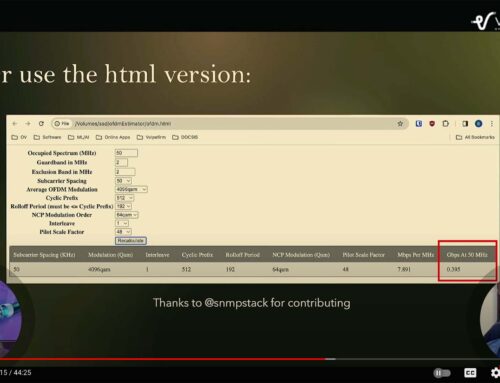Impulse Noise Adaptive Pre-Equalization
One of these things is not like the other – Right?!
For those of you who have attended my seminars you are familiar with adaptive pre-equalization in cable modems (if not I’ll explain it in detail momentarily). Also, if you have done any amount of RF plant troubleshooting you are certainly familiar with Impulse noise (again, I’ll cover this too). But if you are like me, I never knew that the two topics were co-related until very recently at SCTE Expo when a good friend and colleague of mine mentioned this in passing during his presentation. I needed to find out for myself in lab testing in order to be convinced. The testing proved my colleague was correct and further substantiated by colleagues at CableLabs who had conducted similar testing several years prior.
DOCSIS Adaptive Pre-Equalization
First lets discuss adaptive pre-equalization in DOCSIS cable modems. CableLabs defines adaptive pre-equalizers as the following:
A circuit in a DOCSIS 1.1 or newer cable modem that pre-equalizes or pre-distorts the transmitted upstream signal to compensate for channel response impairments. In effect, the circuit creates a digital filter that has approximately the opposite complex frequency response of the channel through which the desired signal is to be transmitted.
CableLabs certainly should know a lot about this topic as they have recently spent a great deal of time researching what can be done with adaptive pre-equalization.
Aside from the definition, the layman explanation of adaptive pre-equalization is as follows: if there are impairments in the HFC plant, the cable modem will attempt to overcome those impairments by pre-distortion. Pre-distortion is the act of transmitting a non-ideal signal which after traversing the HFC plant becomes a more ideal signal by the time it reaches the CMTS. This is better described with visual aids. The next two pictures show a cable modem before and after adaptive pre-equalization at the CMTS.

Pre-distored Cable Modem Signal
Source: CableLabs DOCSIS® Best Practices and Guidelines
The image above shows a cable modem experiencing significant roll-off due to a low pass filter. A CMTS would have great difficulty in recovery any of the 64-QAM-based subscriber data from this cable modem. What is visible is the RF frequency response that would cause very low MER values (23 dB as reported by the CMTS). What is not visible is the group delay at the band edges which are likely far in excess of the DOCSIS 200 ns/MHz requirement. The only reason this cable modem is able to stay online is because the station maintenance bursts are set to a much lower modulation of QPSK or 16-QAM.

Near Ideal Cable Modem Signal after Impairments
Source: CableLabs DOCSIS® Best Practices and Guidelines
This next image shows the identical cable modem under the same circumstances, but look at the frequency response. It is nearly perfectly flat even though it is transmitting well into the lowpass filter. How is this possible? A one-line command was entered into the CMTS which enabled adaptive pre-equalization. When the command was enabled, the CMTS started looking at the RNG-REQ messages coming from each cable modem. The CMTS analyzes the quality of the RNG-REQ message and then determines if the message needs improving. If it does, as in the case of this cable modem, the CMTS includes correction coefficients in the RNG-RSP message to the cable modem. When the cable modem receives the correction coefficients it loads them into internal time delay mechanisms that are called “taps”. These taps are different from the taps used to distribute RF signals in the HFC plant. These are digital time delay taps used in digital signal processing (DSP) circuitry in the cable modem. The cable modem’s internal taps allow the complex DSP to pre-distort the signal as shown in the above images so that it can overcome the roll-off of the lowpass filter as well as the group delay. So if you think about it, the cable modem is simply transmitting at a higher power where the attenuation is greater. With a higher transmit power at higher attenuation, the signal arrives flat after propagating through the HFC plant, thus arriving as a flat signal at the CMTS. There are some more complex things that occur in the DSP to over-come group delay, but you should get the general idea.
The bottom line is that the original signal before pre-equalization was turned on had an MER (SNR) of 23 dB and about 100% un-correctable codeword errors. This means no user data was getting through. After adaptive pre-equalization was turned on MER (SNR) went to 36 dB and codeword errors went to zero. So pre-equalization can be very powerful and make the upstream DOCSIS plant much more robust against impairments such as frequency response, group delay, and micro-reflections.
Impulse Noise
Now that we’ve covered a bunch of good things about adaptive pre-equalization your still wondering what impulse noise has to do with anything discussed so far. Most of you are probably aware that adaptive pre-equalization in fact has no improvement on impulse noise, so why would I write an article that links the two topics together? This is a very good question and one that you will have to read part 2 of this article.
Previous events can be seen under the blog.
- If you are watching this on youtube please hit the subscribe button!
- Let us know what you think and remember to share!
- You can find slides at the bottom of the page and some on slideshare.
- Find out about events or articles by following us on Twitter, LinkedIn or Facebook too.
- We have stuff. Interested in buying some clothes with cable stuff. Click here
Also available on iTunes, Google Podcasts, Spotify, vurbl see podcasts “get your tech on”.





Hi Brady,
What are station maintenance bursts?
Why should they have a low modulation (QPSK,…) to maintain the CM online?
Best regards